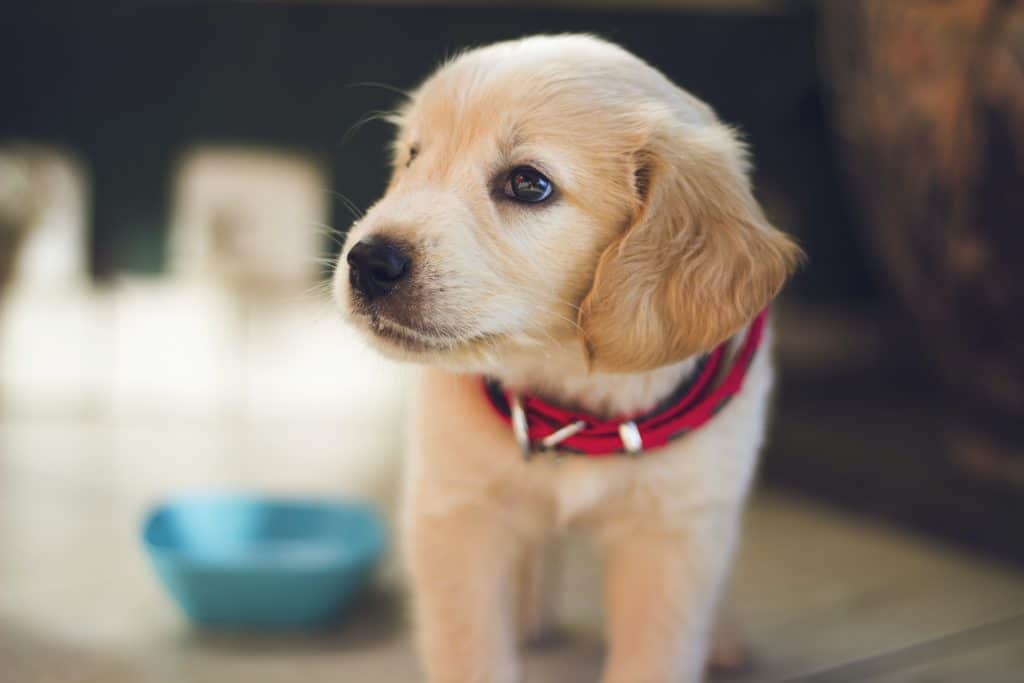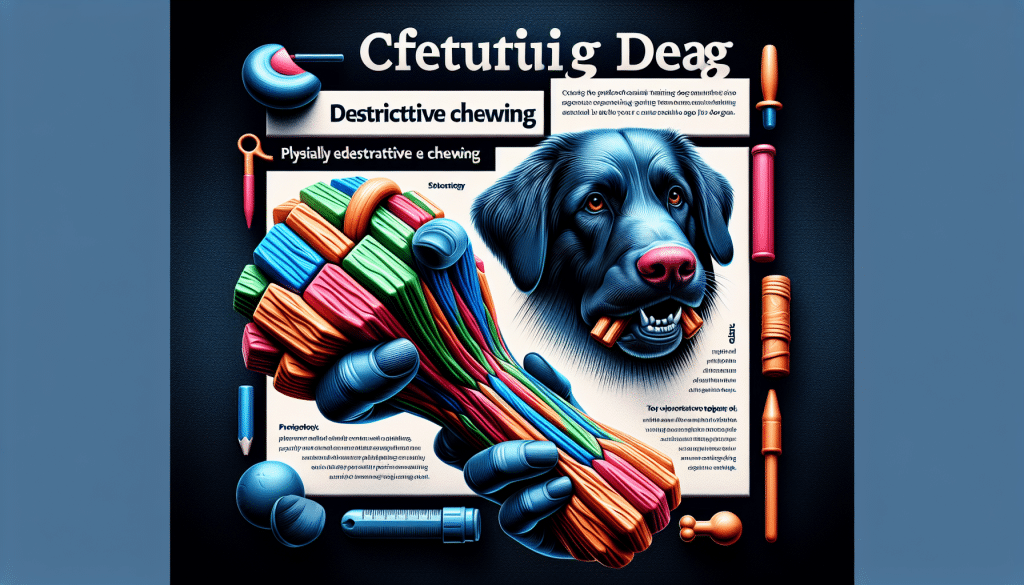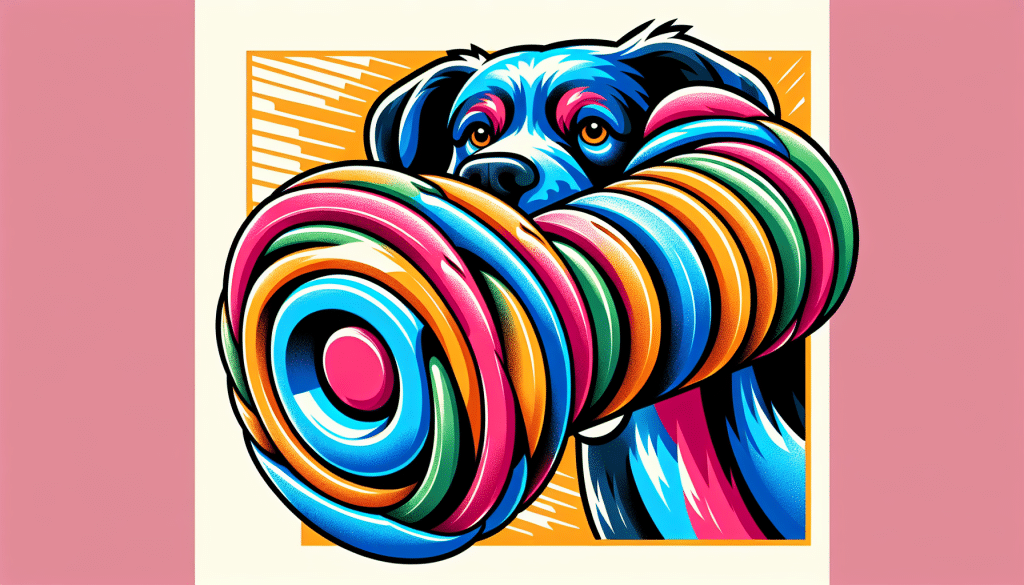Have you ever come home to find your favorite pair of shoes completely annihilated by your beloved furry friend? If the answer is yes, then you understand the frustration of dealing with a dog who just can't seem to resist sinking their teeth into everything they lay their eyes on. But fear not! In this article, we will explore some tried and tested training methods that can effectively reduce excessive chewing in dogs. With a little patience and consistency, you'll soon be able to enjoy a chew-free home and keep your precious belongings intact. Say goodbye to chewed-up shoes and hello to a well-behaved canine companion!

This image is property of images.unsplash.com.
Understanding the causes of excessive chewing
Separation anxiety
Excessive chewing in dogs can often be linked to separation anxiety. When dogs feel anxious or stressed from being separated from their owners, they may resort to chewing as a way to self-soothe or alleviate their anxiety. To address this issue, it is important to gradually desensitize your dog to being alone and provide them with comfort through crate training or the use of calming methods, such as pheromone diffusers or calming music.
Boredom or lack of mental stimulation
Dogs are highly intelligent animals and require mental stimulation to prevent boredom. When dogs are left without appropriate mental enrichment, they may turn to chewing as a way to occupy themselves. Providing your dog with interactive toys, puzzle feeders, or Kong toys stuffed with treats can help alleviate their boredom and redirect their chewing behavior to more productive activities.
Teething or oral discomfort
Similar to human babies, puppies go through a teething stage where their new teeth start to emerge, causing discomfort and irritation in their gums. During this time, puppies may chew on objects to relieve the pain and discomfort. Ensuring that your puppy has access to appropriate chew toys designed specifically for teething can help alleviate their oral discomfort and prevent destructive chewing.
Lack of proper chew toys
If your dog doesn't have access to appropriate chew toys, they may resort to chewing on household items or furniture. It is important to provide your dog with a variety of chew toys that are specifically designed for their size, breed, and chewing habits. Chew toys should be made of durable materials that can withstand the strength of your dog's chewing, and they should provide different textures to keep your dog's interest.
Lack of exercise or physical activity
Dogs need regular exercise and physical activity to release their energy and prevent boredom or restlessness. If your dog is not receiving adequate exercise, they may resort to chewing as a way to alleviate their pent-up energy. Ensuring that your dog receives daily exercise through walks, playtime, or other physical activities can help reduce their excessive chewing behavior.
Positive reinforcement training techniques
Using treats to reward desired behavior
Positive reinforcement training involves rewarding your dog's desired behavior with treats or praise to reinforce that behavior. When it comes to reducing excessive chewing, you can use treats to reward your dog for choosing appropriate chew toys and redirecting their chewing behavior to those toys. This technique helps your dog understand what behavior is expected of them and encourages them to repeat it in the future.
Clicker training for chewing redirection
Clicker training is a form of positive reinforcement training that uses a distinct sound, such as a clicker, to mark the desired behavior. When your dog redirects their chewing behavior to an appropriate chew toy, you can use the clicker to signal that they have done the right thing. Clicker training helps create clear communication between you and your dog and can effectively redirect their chewing to approved items.
Verbal praise and petting as reinforcement
In addition to treats and clicker training, verbal praise and petting can also be effective forms of positive reinforcement for reducing excessive chewing. When your dog chooses an appropriate chew toy or redirects their chewing to a more suitable item, shower them with verbal praise and affectionate pets. This positive reinforcement creates a strong bond between you and your dog and motivates them to continue displaying the desired behavior.
Consistency in training and rewards
Consistency is key when it comes to positive reinforcement training. To effectively reduce excessive chewing, it is important to be consistent in your training methods and rewards. This means consistently redirecting your dog to appropriate chew toys, consistently rewarding them for choosing those toys, and consistently setting boundaries and expectations. By being consistent, your dog will learn what is acceptable and what is not, ultimately reducing their tendency to engage in destructive chewing.

This image is property of images.unsplash.com.
Chew toy selection and management
Choosing appropriate chew toys for different stages
Different dogs have different chewing preferences and needs based on their age, breed, and individual tendencies. When selecting chew toys, it is important to consider these factors to ensure you provide the most suitable options. Puppies may benefit from softer chew toys designed for teething, while adult dogs may require more durable toys. Consulting with a veterinarian or pet store professional can help you choose appropriate chew toys for your dog's specific needs.
Providing a variety of textures and types of toys
Dogs have different preferences when it comes to textures and types of chew toys. Some may prefer rubber toys, while others may enjoy rope toys or plush toys. By providing a variety of textures and types of toys, you can cater to your dog's individual preferences and keep them engaged. This will also prevent them from becoming bored with their toys and seeking out other items to chew.
Size and durability considerations
When selecting chew toys, size and durability are crucial factors to consider. The toy should be appropriately sized for your dog to avoid any potential choking hazards. Additionally, the toy should be durable enough to withstand your dog's chewing strength. If a toy becomes damaged or starts to show signs of wear and tear, it should be replaced to prevent your dog from ingesting any small pieces that may pose a choking hazard.
Rotating toys to maintain interest
Just like humans, dogs can become bored with their toys if they are constantly exposed to the same ones. To prevent this, it is recommended to rotate your dog's toys regularly. Introduce new toys and temporarily put away older ones. This will keep your dog interested and engaged with their toys, reducing the likelihood of them seeking out inappropriate items to chew.
Preventing access to inappropriate objects
In addition to providing appropriate chew toys, it is important to prevent your dog's access to inappropriate objects that they may be tempted to chew. Keep hazardous items, such as shoes, socks, or household chemicals, out of your dog's reach. This can be achieved by using baby gates, closing doors, or utilizing pet-proof containers. By limiting your dog's access to inappropriate objects, you can effectively redirect their chewing behavior to acceptable alternatives.
Socialization and interaction techniques
Increasing socialization opportunities with other dogs
Increasing your dog's socialization opportunities with other dogs can help reduce excessive chewing due to anxiety or boredom. Dogs are naturally social creatures, and interaction with their fellow canines can provide mental and physical stimulation. Consider joining a local dog park, arranging playdates with other friendly dogs, or enrolling your dog in group training classes. These activities will give your dog the chance to burn off energy, make new friends, and reduce the likelihood of resorting to destructive chewing.
Engaging in interactive play sessions
Interactive play sessions with you or other family members can provide valuable mental and physical stimulation for your dog. Engaging in activities such as fetch, tug-of-war, or hide-and-seek allows your dog to release their energy in a positive way. These play sessions also strengthen the bond between you and your dog, making them less likely to engage in destructive chewing when left alone.
Enrolling in obedience or training classes
Obedience or training classes can provide structured learning experiences for your dog, helping them become more well-behaved and mentally stimulated. These classes provide an outlet for your dog's energy and teach them appropriate behaviors. By learning and following commands, your dog will gain confidence and be less likely to engage in excessive chewing out of boredom or anxiety.
Supervised playdates and outings
Supervised playdates and outings with other dogs can also offer mental and physical stimulation for your dog. Whether it's a trip to the dog beach, a hike in the woods, or a simply playdate in your backyard, these interactions give your dog the opportunity to socialize and engage in positive play. This can help reduce their need for chewing and provide them with a healthy outlet for their energy.

This image is property of images.unsplash.com.
Behavioral modification techniques
Chewing deterrent sprays or bitter-tasting solutions
Chewing deterrent sprays or bitter-tasting solutions can be helpful in discouraging dogs from chewing on specific objects. These solutions have an unpleasant taste that deters dogs from continuing to chew on the sprayed items. It is important to use pet-safe products and avoid spraying them directly on your dog's skin or face. Instead, apply the deterrent to objects you want to protect, such as furniture legs or shoes, to discourage chewing.
Environmental management to limit access to tempting items
Environmental management involves making changes to your dog's environment to limit their access to tempting items. For example, if your dog has a habit of chewing on electrical cords, you can use cord covers or block their access to the area where the cords are located. Consider using baby gates, closing doors, or using covers to protect items that your dog finds enticing. By removing or securing potential hazards, you can prevent your dog from engaging in destructive chewing.
Crate training and confinement during unsupervised periods
Crate training can be an effective way to manage your dog's behavior and limit their destructive chewing during unsupervised periods. When properly introduced and used, a crate can provide your dog with a secure and den-like environment, reducing their anxiety and preventing access to inappropriate objects. Make sure the crate is appropriately sized for your dog and provide them with comfortable bedding and stimulating chew toys. Never use the crate as a form of punishment, and gradually increase the duration of crate confinement to ensure your dog feels comfortable and secure.
Using deterrent devices like indoor pet gates
Indoor pet gates can be used to limit your dog's access to certain areas of your home where they may be tempted to chew on furniture, or other items. By confining your dog to a specific area with appropriate chew toys, you can redirect their chewing behavior and prevent them from damaging your belongings. Pet gates are easy to install and can be a useful tool in managing your dog's behavior.
Professional help and guidance
Consulting with a veterinarian or animal behaviorist
If your dog's excessive chewing persists despite your best efforts, it may be beneficial to consult with a veterinarian or animal behaviorist. They can help determine if there are any underlying medical or behavioral issues contributing to the behavior and provide tailored advice and guidance. A professional can also aid in creating a comprehensive training and behavior modification plan specifically designed for your dog's needs.
Seeking assistance from a professional dog trainer
Working with a professional dog trainer can provide support and guidance in addressing excessive chewing. A trainer can assess your dog's behavior, identify any training gaps, and help develop a training plan to reduce destructive chewing. They can offer expertise in positive reinforcement methods and help you implement consistent training techniques. With their guidance, you can establish a strong bond with your dog and effectively address their chewing behavior.

Correction techniques to avoid
Avoid physical punishment or yelling
Using physical punishment or yelling as a means of correcting your dog's chewing behavior is ineffective and can lead to negative consequences. Such methods can cause fear and anxiety in your dog, potentially exacerbating the problem instead of addressing it. Instead, focus on positive reinforcement techniques and redirecting your dog to appropriate chew toys when they engage in chewing behavior.
Avoid outdated dominance-based training methods
Dominance-based training methods, such as alpha rolling or using physical force to assert dominance over your dog, have been widely debunked and can be harmful to your dog's well-being. These methods can create fear and anxiety in your dog, leading to more problematic behaviors. It is recommended to focus on positive reinforcement training techniques that build trust and strengthen the bond between you and your dog.
Patience and consistency in training
Understanding that training takes time and repetition
Reducing excessive chewing in dogs requires patience and consistency. Training is a gradual process that takes time and repetition. It is important to remember that your dog is learning new behaviors, and it may take several weeks or even months for the training to fully take effect. Be patient with your dog and celebrate their progress along the way.
Consistently reinforcing desired behavior
Consistency is crucial when it comes to training your dog. Reinforce the desired behavior of choosing appropriate chew toys every time you catch your dog engaging in it. Consistently redirect their chewing behavior and reward them with treats, praise, or petting. By consistently reinforcing the desired behavior, your dog will come to understand what is expected of them and be more inclined to repeat it.
Avoiding mixed signals or inconsistency in commands
Clear and consistent communication is essential during training. Avoid sending mixed signals by allowing your dog to chew on inappropriate items sometimes and not others. This inconsistency can confuse your dog and undo the progress you have made. Set clear boundaries and consistently redirect their chewing to appropriate chew toys. By providing consistent commands and expectations, you will help your dog understand what is acceptable chewing behavior.

Creating a safe and stimulating environment
Removing and securing potential hazards
To prevent excessive chewing, it is important to create a safe environment for your dog. Identify potential hazards such as loose cables, poisonous plants, or small objects that your dog may be tempted to chew on. Secure these items or remove them from your dog's reach. By eliminating potential hazards, you can reduce the likelihood of destructive chewing and keep your dog safe from harm.
Providing interactive toys and puzzle feeders
Interactive toys and puzzle feeders can provide mental stimulation and engage your dog's natural problem-solving instincts. These toys require your dog to work for their treats or kibble, keeping them occupied and mentally engaged. By providing these toys, you can redirect your dog's chewing behavior to more productive activities and prevent boredom.
Using positive distractions to redirect chewing behavior
When you catch your dog engaging in excessive chewing, it is important to redirect their attention to appropriate chew toys. Offering an alternative toy or engaging them in interactive play can effectively redirect their chewing behavior. By providing positive distractions, you can redirect their energy and prevent them from damaging your belongings.
Health considerations to rule out
Checking for dental problems or discomfort
Excessive chewing can sometimes be a sign of dental problems or oral discomfort. It is important to regularly check your dog's teeth and gums for any signs of dental issues, such as redness, swelling, or bad breath. If you suspect dental problems, consult with your veterinarian to address the issue and provide appropriate treatment. Treating any underlying dental conditions can help alleviate your dog's discomfort and reduce their need for excessive chewing.
Excluding medical conditions causing excessive chewing
In some cases, excessive chewing can be a symptom of an underlying medical condition. Conditions such as allergies, gastrointestinal issues, or hormonal imbalances can cause dogs to engage in destructive chewing. If your dog's excessive chewing is accompanied by other symptoms, such as weight loss, vomiting, or skin irritations, it is important to consult with your veterinarian to rule out any potential medical causes. Identifying and treating any underlying medical conditions can help alleviate your dog's chewing behavior.



1 comment
[…] instincts: Train your dog to respond to commands such as "quiet" or "enough." Socialize them with other animals and people in […]
Comments are closed.